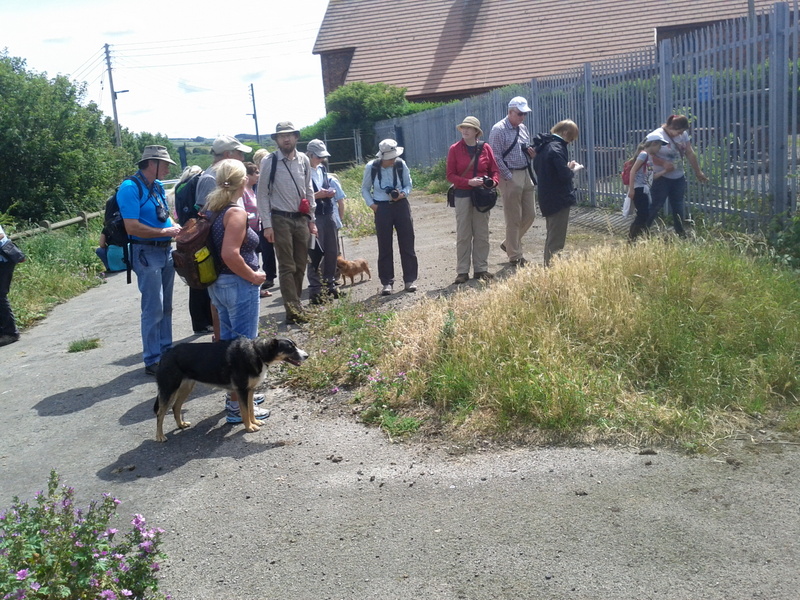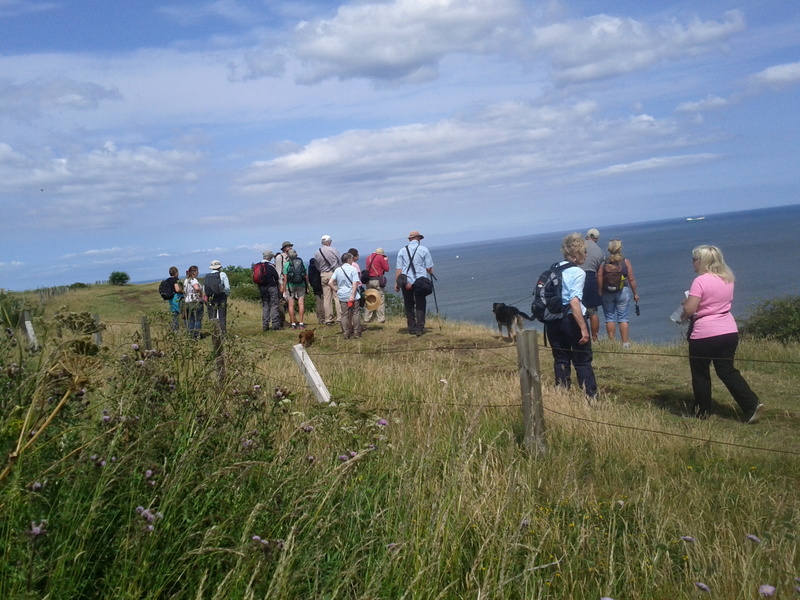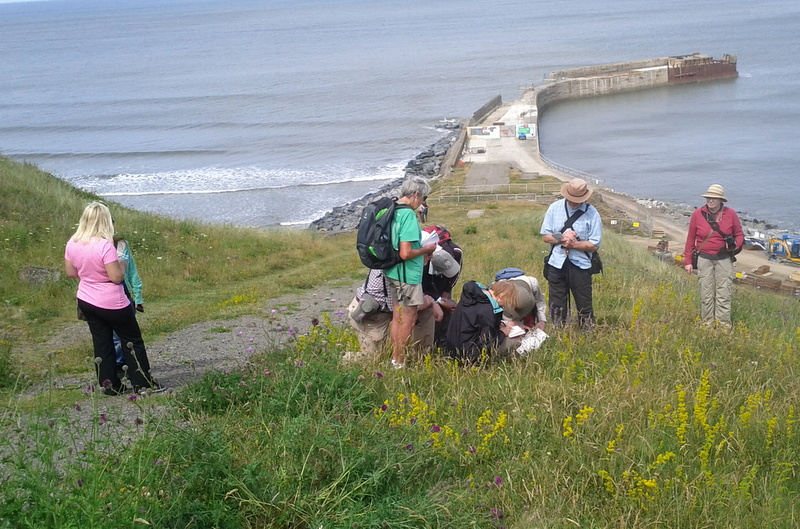Skinningrove
The flower map for Skinningrove can be found using the link below.
Skinningrove Flower Walk (pdf)
Cattersty Sands – Saturday afternoon on the 11th of July
Posted on 20th July 2015 by Martin Allen
A bright and windy day with the sun occasionally peeping through the cloud.
We started with the purple flowered Common Mallow in the car park which was looking magnificent in full flower and could be seen as a tall plant almost six feet high as well as a low flattened plant under a foot high. Then the massed yellow flowers of what was probably Hoary Mustard growing in the disturbed soil on the far side of the recently installed safety barrier; probably because whilst the pods looked waisted the stems were more the bristliness of Black Mustard than the white hairs of Hoary Mustard…it shows the problems of identifying some plants. We wandered on to look at White Stonecrop growing on the flat tarmac of an old road and also a lettuce flower spike (yes a lettuce…a relative of the one you might grow in the garden) but was it Great Lettuce or Prickly Lettuce? We found out following a fascinating bit of investigation…but not until the very end of the walk, so you’ll have to read the rest if you want to find out (you do want).
The flat grassy area on the top of the slope had previously been industrial iron works but had been reclaimed recently when wildflower seed was sown. There were large patches of yellow-flowered Lady’s Bedstraw (smelling rather almondy) dotted with large purple splodges of Greater Knapweed and pale blue Field Scabious. At the corner of the cliff where there are spectacular views across the cliffs and out to sea, we saw the first of the Pyramidal Orchids of our walk (by the end we must have seen thousands dotted amongst the grass and all at the peak of flower with some slight variation between them of purple and pink). Amongst them were the remains of many pale-purple spikes of Common Spotted-orchid and four plants of Bee Orchid just at the end of their flowering period. All the orchids here will have arrived naturally, their tiny seed blown from elsewhere on the cliff faces where they grew before the industry arrived.
Walking down the slipway towards the quay were more orchids and a single plant of Wild Clary which I suspect found its way there as part of a wildflower seed mix.
At the top of the dunes here were a few Marsh Fragrant-orchids (they are indeed fragrant…put your nose close to the flower and breathe in) and then at the end of the dunes, above the sandy beach, the prettiest combination of delicate blue Harebells and the white lacy Burnet-saxifrage punctuated by dots of the ever present pink Pyramidal Orchid.
More wildflowers up the steps, then another spectacular view out to sea (good excuse to pause and recover from the climb) and Pyramidal Orchids in the grassland behind us, before the walk back where we were able to compare the similar looking Weld and Wild Mignonette which happened to be growing near to each other.
That lettuce…well, we snapped a leaf and a white latex-like sap leaked out…after three minutes it started to go orange and that only happens with Great Lettuce; identity solved.
Cattersty: Thursday 23rd July in the evening
Posted on 30th July 2015 by Martin Allen
We all gathered at the car park and stared transfixed (first plant we looked at, so people are bound to be genuinely interested) at the Hoary Mustard behind the crash barrier which was a mass of quite small nondescript yellow flowers. If you’ve been following the saga of the Hoary Mustard over these reports you’ll be delighted to know the pods have developed to such an extent that there is no doubt that it’s Hoary Mustard. We walked past the church to see the white and pink funnel-shaped flowers of Field Bindweed, the White Stonecrop growing on a sprinkling of soil on top of a tarmac road, and growing in the cracks Common Mallow now in seed and then Mugwort in flower (the flowers were pale green so it was hard to tell).
Further along towards the cliff edge and we stopped to look at the wildflowers that had been seeded on this area when it was transformed from an industrial site more than 25 years ago. Lady’s Bedstraw was at peak flower with large patches of tiny yellow flowers throughout punctuated by taller plants of Greater Knapweed (purple), Field Scabious (blue) and the odd Common Knapweed (also purple and we looked at the differences between it and Greater Knapweed…because we could).
There were still flower spikes of Pyramidal Orchid to be seen although they had lost their namesake shape and were a bit more ovally-orchids to be honest; they still looked stunning.
Down the slipway path towards the jetty was Tall or Golden Melilot and the tiny white flowers (and plants) of Fairy Flax.
As we reached the raised sand-dunes we stopped we stopped just at the edge to sniff the Marsh Fagrant-orchid and then went on to discern the difference between Yarrow, Wild Carrot, and the very beautiful Burnet–saxifrage which all had very similar white flowers and by similar I mean pretty much the same unless you look closely and since the whole point of the walk was to look closely I made people look closely until they could work out which was which. At the back of the dunes were large patches of tall pink-flowered Hemp-agrimony and some smaller Common Fleabane just opening its yellow daisy-like flowers.
A swift walk to the end of the dunes then through masses of Burnet-saxifrage only to be met with wave upon wave of Harebells as we topped a dune and went down the other side. I’ve never seen so many in one place and of such variation in colour – from pale blue to dark blue (even a white one) – and form as some bells pointed upward and were quite small, and others large and hanging as we would expect; a total delight.
I hopped down onto the beach and brought back a sample of Frosted Orache and Sea Rocket (which was growing all along the very top of the beach in a line) for everyone to look at closely and then as we were meandering back a couple of boats appeared and so we stopped to watch as huge boulders were pushed off the end into the water to be later used to reinforce the pier, before wending our way in the evening sun back up to where the cars were parked.







